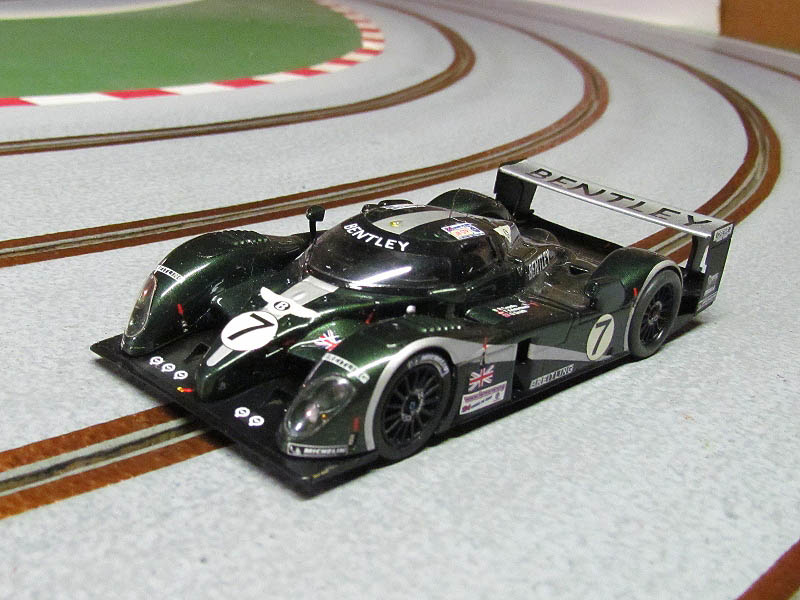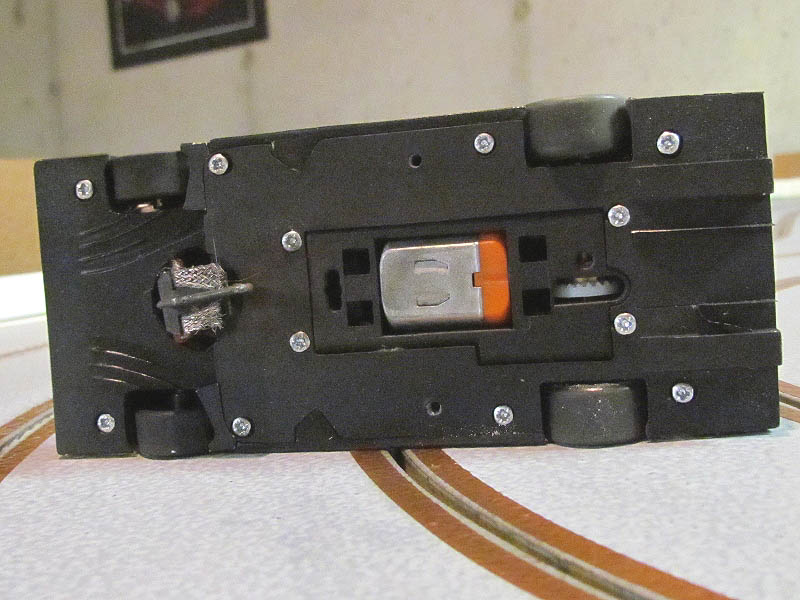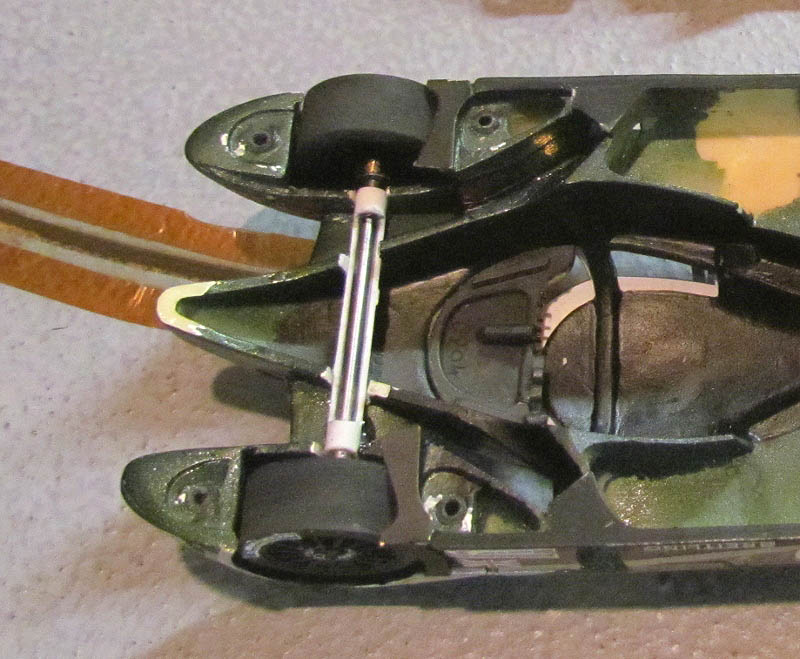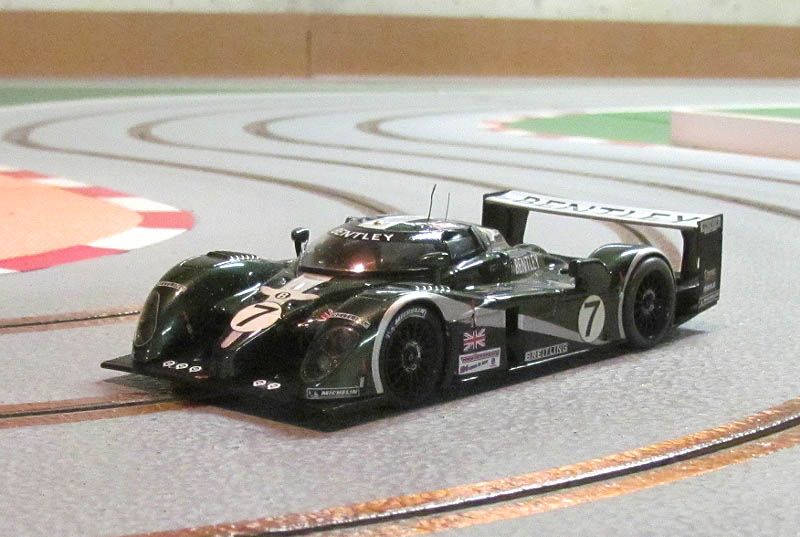
09/11/2012

Le Mans Miniatures Bentley Speed 8
Is It Worth the Price?
By Kurt “El Secundo” Moser
In 2003, Bentley fielded a pair of Speed 8’s at Le Mans. With just two years of development after Bentley’s 73 year hiatus, Bentley claimed the endurance classic. It probably didn’t hurt that Audi was absent that year, and since Bentley and Audi shared a stable in the Volkswagen group, Bentley shared some technology from Audi and had some assistance from the Joest guys. And technically, they were the only two cars in the top class that year, LMGTP. Nevertheless, Bentley won at Le Mans with the Speed 8, a great accomplishment by any standard. Both cars ran the distance, the #7 car taking top honors with 377 laps, and the #8 not far off with 375.
On the plate today is another project car, of sorts. Emboldened by the last Le Mans Miniatures adventure, it was time to wrestle something a little more challenging. LMM released the Le Mans winning Bentley Speed 8 several years ago, and after letting it sit on the shelf for ages, it was time to risk it all by putting it on the track in a shelf-queen-no-more extravaganza. So with a little excitement tinged with outright fear, the Bentley came out of the box, and the work started.

One of the most endearing features from Le Mans Miniatures is the ‘discovery phase’. This is the period after which you take a LMM car out of the box, and discover all the goofy things LMM did before putting the car in the box in the first place. LMM, while ambitious (and very successful) with the detailing, has a reputation for failing spectacularly with all the bits and pieces that turn an attractive car body into a slot car. Their approach is a little random, and they do things no one would even consider on a slot car – no one who has ever seen a slot car, anyway.


So it was no big surprise to find a lot of resistance when lifting the car out of the box, leaving one to wonder if something was still holding the Bentley on its base. That thing holding the car in the box turned out to be gravity, as the Bentley weighs in at an astonishing 136 grams -- a veritable brick on wheels, albeit a really fantastic looking brick.


Flipping the brick upside down reveals a Slot.It motor pod and motor (encouraging news), plus eight chassis screws (not so encouraging news). Removing the screws unleashes a festival of surprises.


First, it’s a 3-piece chassis, in which the front two screws hold on the Bentley’s front splitter, and the aft six screws hold on everything else. Second, once the splitter is removed, we find that the front axle assembly mounts not on the chassis, but on the body. Since the holes in the resin body aren’t quite located properly, the front tires rub outrageously on the tight-fitting bodywork. Modern LMP cars have precious little clearance in the wheel arches, which can pose quite a problem for the slot car makers, and Le Mans Miniatures ran into difficulties here.
The process of fixing the front wheel clearance led to the next Le Mans Miniatures head-scratcher, as the front wheels proved to be extremely heavy. On closer inspection, they turned out to be made of solid brass – more apt for use on a train than a slot car. Nothing says ‘performance’ in a slot car like attaching metal ingots to the axles. Finding replacement LMP wheels shouldn’t be hard, but keep them if you want to enjoy the full Le Mans Miniatures experience.
Motor wires were stuffed into the tight confines of the Bentley bodywork, and were easily an inch too long. They were soldered to the braids, which were thankfully thin and Slot.It-like. Unfortunately, they were mounted on a small guide which was apparently cast in resin, and mounted at a pivot behind the front axle. This weak guide broke at the post in short order, prompting the need to modify another guide to fit LMM’s non-standard guide holder. A new guide, a little surgery to make it fit, another minute to shorten the motor leads, a touch of soldering, and the Bentley is back in business.
Before jumping to the conclusion that the LMM Bentley is all headaches, it’s worth pointing out that nothing had to be done at the back end of the car besides changing tires. The tires weren’t horrible, but they weren’t good, either, and they were the weak spot in the Slot.It pod rear end. Since all this handling and mucking about with the chassis had rubbed off a good portion of the Michelin decals on the rear tires, replacing the tires became a viable option. Paul Gage Fly Classic tires appear too wide and too small in diameter, but stretch to fit nicely. It’s an odd fit, with the inner edge of the tire hanging slightly over the inner edge of the wide-ribbed brass wheel, but the fit works surprisingly well. The sidewall is a bit too rounded for a modern LMP car, but some sanding should take care of that.
Besides the guide, the most critical element needing attention was undoubtedly the front axle arrangement, which could best be described as ‘Mongolian’ and ‘cluster-like’. No solutions were forthcoming from the usual source (the Magic 8-Ball reported “answer hazy, ask again later”), so the best option was to add a piece of styrene tubing as a sleeve for the front axle. With some delicate carving of the resin and many test-fittings, the front wheels were soon centered nicely in the wheel arches.

All this done, some oiling, and a touch of tire sanding, and the Bentley is ready for the track. Without that little bit of drag up front, the urethane tires could really do their job in the back, and the Bentley went from tail-happy to smooth, arrow-straight motoring. On wood tracks, the urethanes really get a little bite, and the Speed 8 tracks smoothly with very little hint of wag. In short, it drives like an LMP should. Once the car gets appropriate grip, you will never notice the awkward guide placement that can make a car look unnatural going around corners.
Once again, Le Mans Miniatures delivers another beautiful car that with a little work, is smooth and great fun to drive. A race winner? No, not at 136 grams with brass wheels at all four corners. But the smooth drive and stunning on-track appearance make it a winner. When everything comes together on a LMM car, the result has no equal. For the cost of the car, plus a pair of tires and a few stray bits and pieces, and the ‘cost’ of spending a fun evening with friends fiddling around, we have a car that’s truly special. For those of you who would pay collector prices for Carrera’s version of the Bentley Speed 8, a few dollars more gives you a car that’s no harder to work on, and makes the Carrera version look like it was molded out of clay and cardboard by a kid in elementary school. Ultimately, only the buyer can determine whether these cars are worth the price, but LMM has moved to the top of my personal buying list. In the end, the LMM cars are as much fun as anything else, but also very satisfying when you’ve finally turned that rough diamond into a sparkling gem.

My thanks go to two guys, Mark Thomas and Bruce at CincySlots. Thanks to Mark, who not only had the tires, tubing, and spare guide on hand, but let me hang out in his workshop for an evening to do all the hammering, sawing, soldering, fitting, cutting, and occasional swearing. For a slot car guy, spending time in Mark’s basement is like getting a golden ticket to visit Willy Wonka’s chocolate factory, without the uncomfortable trip to the de-juicing room. And thanks to Bruce, who gave me a nice price on the car due to its broken wing and smooshed antenna, and without those, I never would have tackled this car.
-Kurt
Copyright © 2012 HomeRacingWorld.com All Rights Reserved